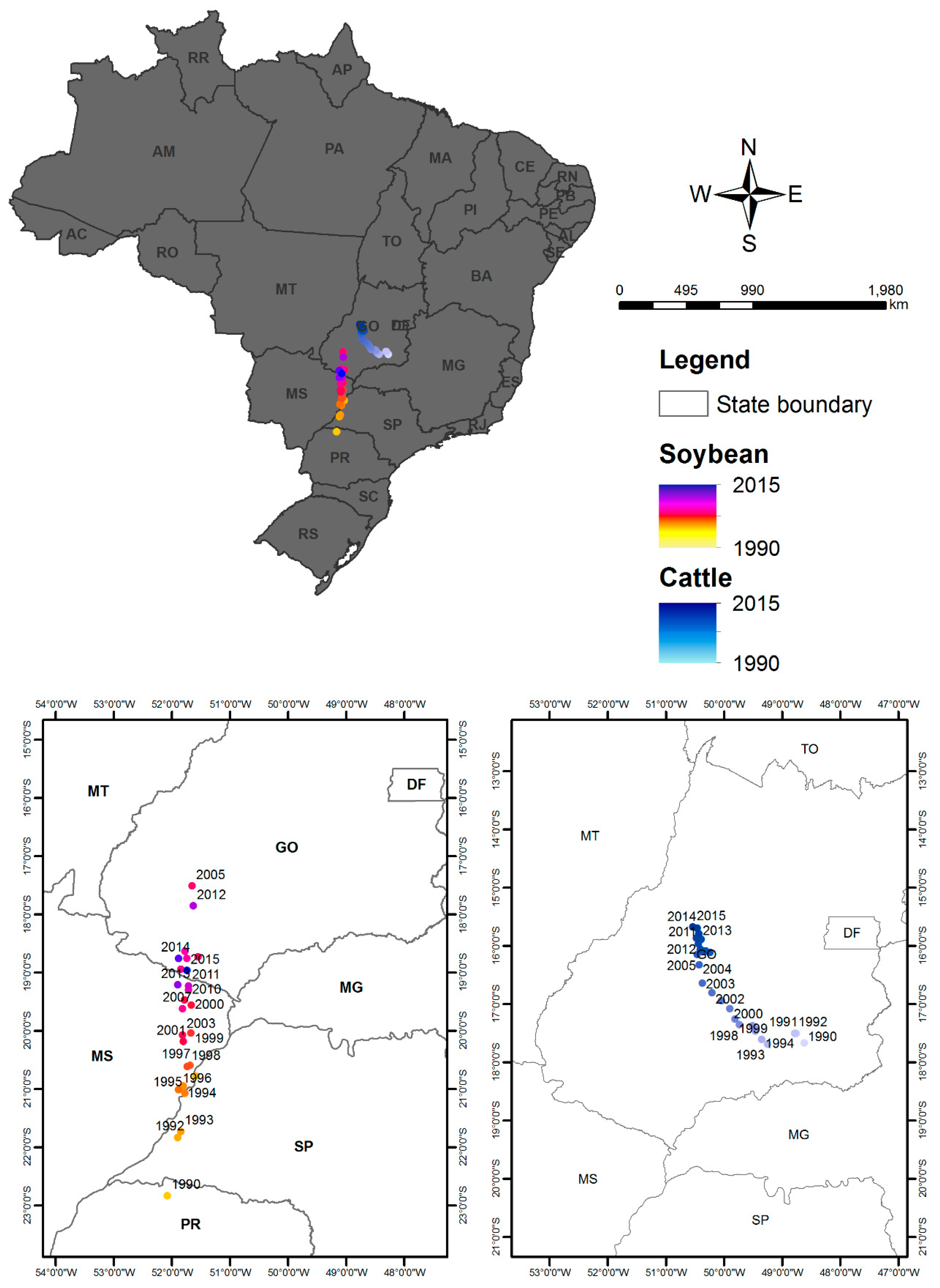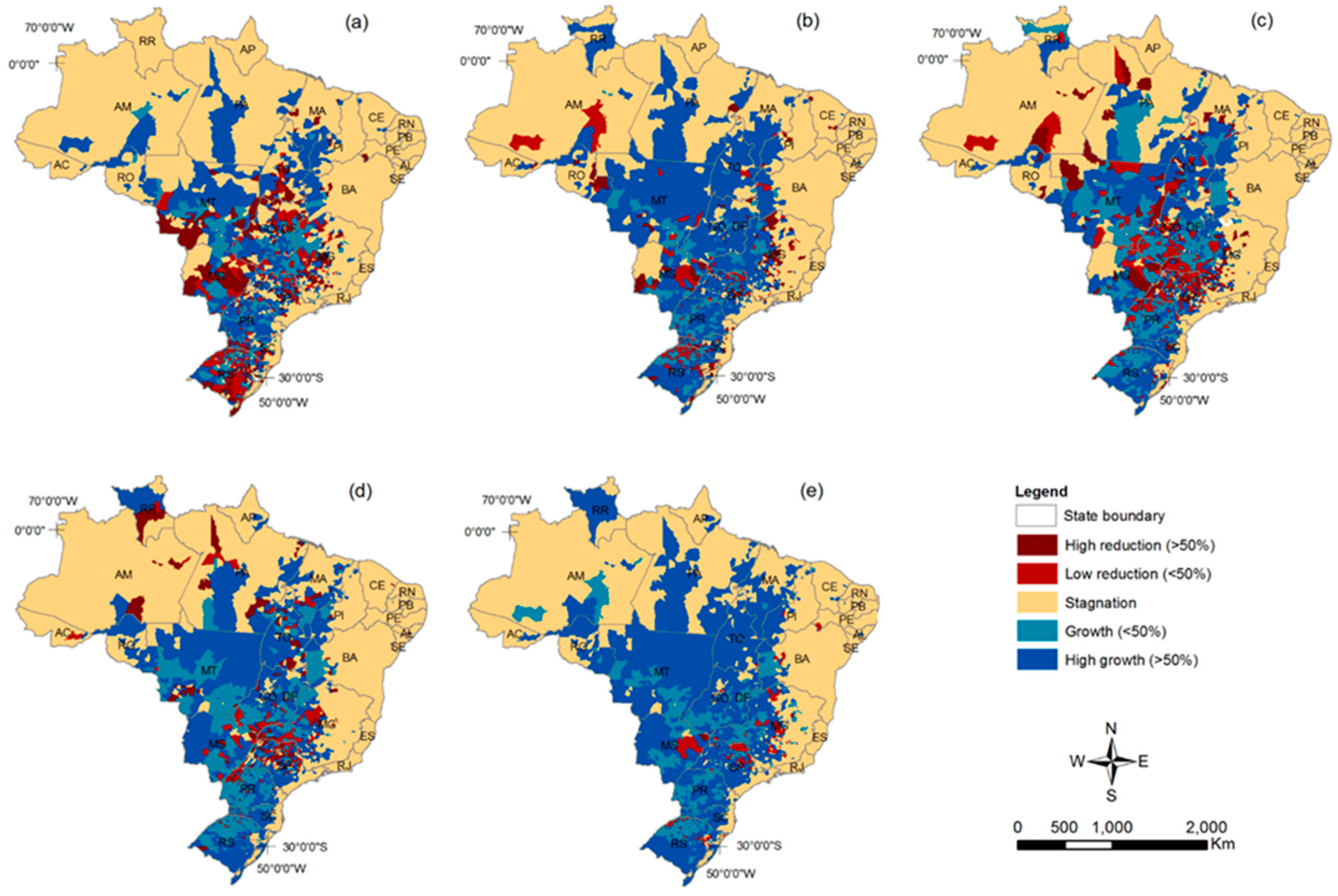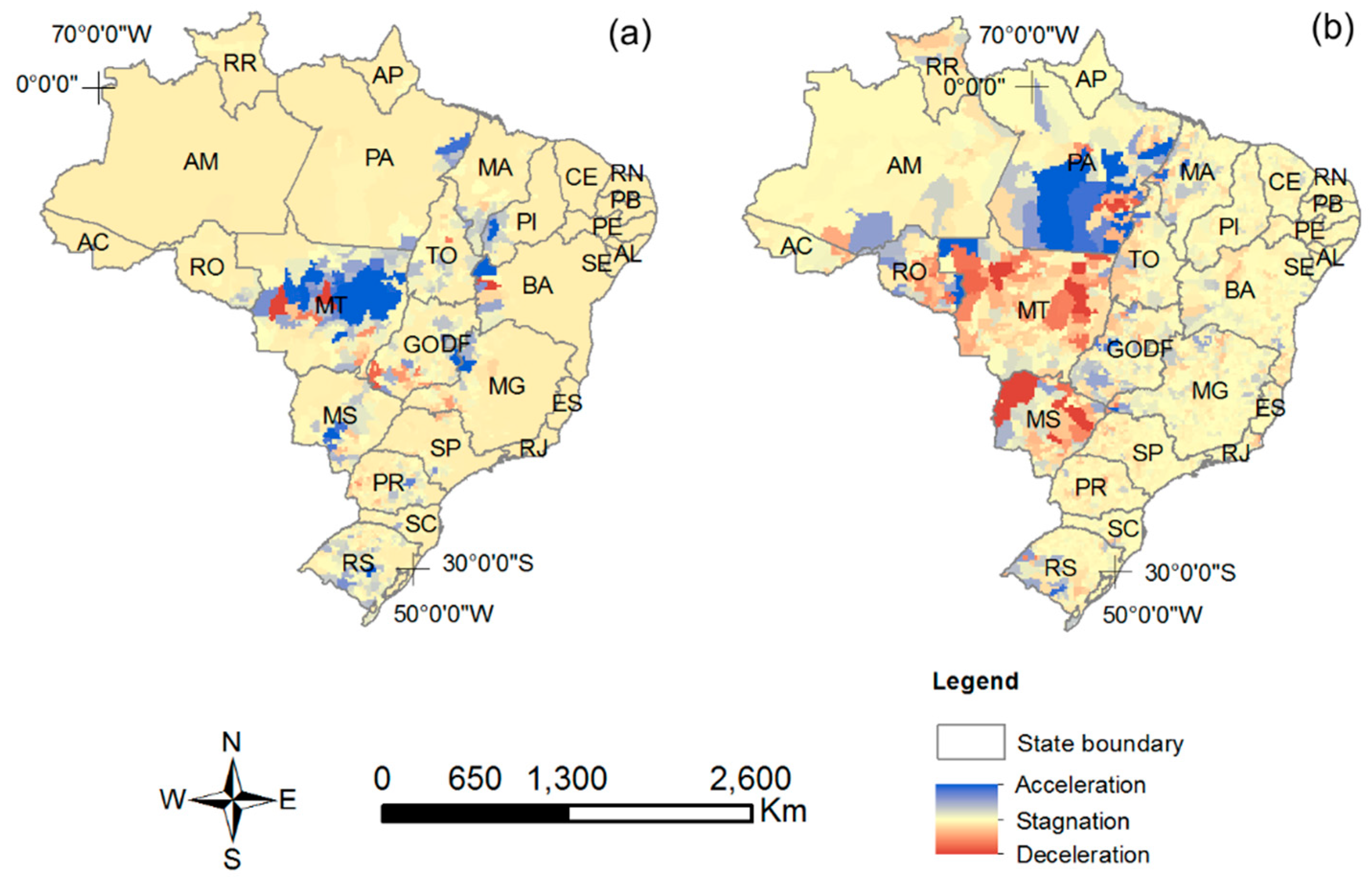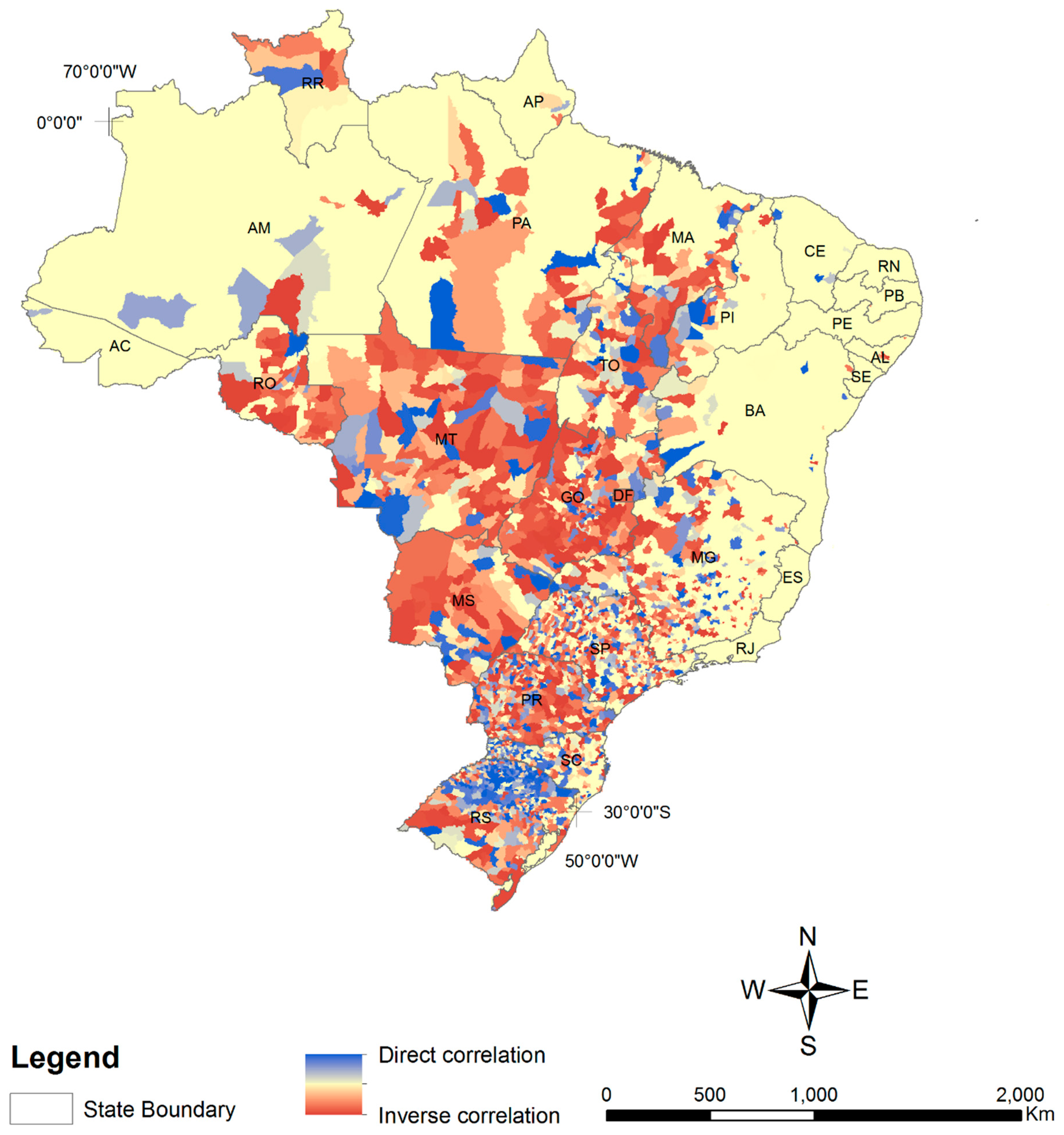The Spatiotemporal Dynamics of Soybean and Cattle Production in Brazil
Abstract
1. Introduction
2. Materials and Methods
3. Results
4. Discussion
5. Conclusions
Author Contributions
Funding
Conflicts of Interest
References
- OECD/Food and Agriculture Organization of the United Nations. OECD-FAO Agricultural Outlook 2015; OECD Publishing: Paris, France, 2015. [Google Scholar] [CrossRef]
- Flingenspan, F.B.; Cunha, A.M.; Lélis, M.T.C.; Lima, M.G. As exportações do Brasil nos anos 2000: Evolução, market share e padrões de especialização a partir de distintas agregações setoriais. Indic. Econ. FEE 2015, 42, 41–56. Available online: https://revistas.fee.tche.br/index.php/indicadores/article/view/3502 (accessed on 29 January 2019).
- Figueiredo, E.V.C.; Contini, E. China: Gigante também na agricultura. Rev. Polít. Agríc. 2013, 22, 5–29. Available online: https://ainfo.cnptia.embrapa.br/digital/bitstream/item/88424/1/CHINA-GIGANTE-TAMBEM-NA-AGRICULTURA.pdf (accessed on 29 January 2019).
- Brazilian Institute of Geography and Statistics—IBGE. Sistema IBGE de Recuperação Automática—SIDRA. Available online: https://sidra.ibge.gov.br/ (accessed on 29 January 2019).
- The Food and Agriculture Organization—FAO. FAOSTAT. Available online: http://faostat3.fao.org/ (accessed on 29 January 2019).
- Companhia Nacional de Abastecimento—CONAB. Perspectivas Para a Agropecuária—V.3—Safra 2015/2016; CONAB: Brasília, Brazil, 2015. Available online: file:///C:/Users/caradepeixe123/Downloads/Perspectivas_para_a_Agropecuaria_-_V.3_-_Safra_2015-2016.pdf (accessed on 29 January 2019).
- Cremonez, P.A.; Feroldi, M.; Nadaleti, W.C.; Rossi, E.; Feiden, A.; Camargo, M.P.; Cremonez, F.E.; Klajn, F.F. Biodiesel production in Brazil: Current scenario and perspectives. Renew. Sustain. Energy Rev. 2015, 42, 415–428. [Google Scholar] [CrossRef]
- Byerlee, A.; Stevenson, J.; Villoria, N. Does intensification slow crop land expansion or encourage deforestation? Glob. Food Secur. 2014, 3, 92–98. [Google Scholar] [CrossRef]
- Barona, E.; Ramankutty, N.; Hyman, G.; Coomes, O.T. The role of pasture and soybean in deforestation of the Brazilian Amazon. Environ. Res. Lett. 2010, 5, 1–9. [Google Scholar] [CrossRef]
- Scheffler, R.; Neill, C.; Krusche, A.V.; Elsenbeer, H. Soil hydraulic response to land-use change associated with the recent soybean expansion at the Amazon agricultural frontier. Agric. Ecosyst. Environ. 2011, 144, 281–289. [Google Scholar] [CrossRef]
- Bowman, M.; Soares-Filho, B.; Merry, F.; Nepstad, D.; Rodrigues, H.; Almeida, O. Persistence of cattle ranching in the Brazilian Amazon: A spatial analysis of the rationale for beef production. Land Use Policy 2012, 29, 558–568. [Google Scholar] [CrossRef]
- Gollnow, F.; Lakes, T. Policy change, land use, and agriculture: The case of soy production and cattle ranching in Brazil, 2001–2012. Appl. Geogr. 2014, 55, 203–211. [Google Scholar] [CrossRef]
- Mann, M.L.; Kaufmann, R.K.; Bauer, D.M.; Gopal, S.; Nomack, M.; Womack, J.Y.; Sullivan, K.; Soares-Filho, B.S. Pasture conversion and competitive cattle rents in the Amazon. Ecol. Econ. 2014, 97, 182–190. [Google Scholar] [CrossRef]
- Brown, J.C.; Koeppe, M.; Coles, B.; Price, K.P. Soybean production and conversion of tropical forest in the Brazilian Amazon: The case of Vilhena, Rondônia. Ambio 2005, 34, 462–469. [Google Scholar] [CrossRef] [PubMed]
- Morton, D.C.; DeFries, R.S.; Shimabukuro, Y.E.; Anderson, L.O.; Arai, E.; Espiritu-Santo, F.B.; Freitas, R.; Morisette, J. Cropland expansion changes deforestation dynamics in the southern Brazilian Amazon. Proc. Natl. Acad. Sci. USA 2006, 103, 14637–14641. [Google Scholar] [CrossRef] [PubMed]
- Mcmanus, C.M.; Barcellos, J.O.J.; Formenton, B.K.; Hermuche, P.M.; de Carvalho Júnior, O.A.; Guimaraes, R.F.; Gianezini, M.; Dias, E.A.; Lampert, V.N.; Zago, D.; et al. Dynamics of cattle production in Brazil. PLoS ONE 2016, 11. [Google Scholar] [CrossRef] [PubMed]
- Costa, N.S.; Hermuche, P.M.; Cobuci, J.A.; Paiva, S.R.; Guimaraes, R.F.; de Carvalho Júnior, O.A.; Costa, C.N.; Mcmanus, C.M. Georeferenced evaluation of genetic breeding value patterns in Brazilian Holstein cattle. Genet. Mol. Res. 2014, 13, 9806–9816. [Google Scholar] [CrossRef] [PubMed]
- Hermuche, P.M.; Guimaraes, R.F.; de Carvalho Júnior, O.A.; Gomes, R.A.T.; Paiva, S.R. Environmental factors that affect sheep production in Brazil. Appl. Geogr. 2013, 44, 172–181. [Google Scholar] [CrossRef]
- Hermuche, P.M.; Maranhão, R.L.A.; Guimarães, R.F.; de Carvalho Júnior, O.A.; Gomes, R.A.T.; Paiva, S.R.; McManus, C.M. Dynamics of sheep production in Brazil. ISPRS Int. J. Geoinf. 2013, 2, 665–679. [Google Scholar] [CrossRef]
- Clemente, A.M.; Carvalho Júnior, O.A.; Guimarâes, R.F.; Mcmanus, C.M.; Turazi, C.M.V.; Hermuche, P.M. Spatial-Temporal Patterns of Bean Crop in Brazil over the Period 1990–2013. ISPRS Int. J. Geoinf. 2017, 6, 107. [Google Scholar] [CrossRef]
- Manzatto, C.V.; Freitas Júnior, E.; Peres, J.R.R. Uso agrícola dos Solos Brasileiros; Embrapa: Rio de Janeiro, Brazil, 2002; Available online: https://ainfo.cnptia.embrapa.br/digital/bitstream/item/146673/1/Cap9-Tatiana.pdf (accessed on 29 January 2019).
- Duarte, J.O.; Garcia, J.C.; Matoso, M.J. Influência da Evolução do Uso do Sistema de Plantio Direto no Crescimento da Área Plantada com Sorgo no Cerrado. In Proceedings of the 26° Congresso Nacional de Milho e Sorgo, Belo Horizonte, Brazil, 27–31 August 2006; Available online: http://www.bdpa.Cnptia.embrapa.br/consulta/busca?b=ad&id=490259&biblioteca=vazio&busca=490259&qFacets=490259&sort=&paginacao=t&paginaAtual=1 (accessed on 29 January 2019).
- Castro, C.N. A agropecuária na região Centro-Oeste: Limitações ao Desenvolvimento e Desafios Futuros. In Texto para Discussão, Instituto de Pesquisa Econômica Aplicada (IPEA); 2014; 1923, pp. 7–41. Available online: http://repositorio.ipea.gov.br/bitstream/11058/2655/1/TD_1923.pdf (accessed on 29 January 2019).
- Pereira, P.A.A.; Martha, G.B.; Santana, C.A.M.; Alves, E. The development of Brazilian agriculture, future technological challenges and opportunities. Agric. Food Secur. 2012, 1, 1–12. [Google Scholar] [CrossRef]
- Pires, M.J.S.; Santos, G.R. Modelo Agroexportador, Política Macroeconômica e a Supremacia do Mercado: Uma Visão do Modelo Brasileiro de Exportação de Commodities. In Texto para Discussão, Instituto de Pesquisa Econômica Aplicada (IPEA); 2013; 1817, pp. 7–29. Available online: http://www.ipea.gov.br/portal/index.php?option=com_content&view=article&id=17236 (accessed on 29 January 2019).
- Vieira Filho, J.E.R. Transformação histórica e padrões tecnológicos da agricultura brasileira. In O Mundo Rural no Brasil do Século 21: A Formação de um Novo Padrão Agrário e Agrícola; Buainain, A.M., Alves, E., Silveira, J.M., Navarro, Z., Eds.; Embrapa Press: Brasília, DF, Brazil, 2014; pp. 395–421. [Google Scholar]
- World Bank. Food Price Watch; World Bank: Washington, DC, USA, 2011; Available online: https://siteresources.worldbank.org/EXTPOVERTY/Resources/336991-1311966520397/Food-Price-Watch-August-2012.pdf (accessed on 29 January 2019).
- Fukase, E.; Martin, W. Who will feed China in the 21st century? Income growth and food demand and supply in China. J. Agric. Econ. 2016, 67, 3–23. [Google Scholar] [CrossRef]
- Mcfarlane, I.; O’connor, E. World soybean trade: Growth and sustainability. Mod. Econ. 2014, 5, 580–588. [Google Scholar] [CrossRef][Green Version]
- Castelo, T.B.; Almeida, O.T. Desmatamento e Uso da Terra no Pará. Rev. Polít. Agríc. 2015, 24, 99–111. Available online: https://ainfo.cnptia.embrapa.br/digital/bitstream/item/126826/1/Desmatamento-e-uso-da-terra.pdf (accessed on 29 January 2019).
- United States Department of Agriculture—USDA. Brazil: Oilseeds and Products annual Planted Area to Hit Record for Ninth Consecutive Year. Gain Report BR1806; 2018; pp. 1–12. Available online: https://gain.fas.usda.gov/Recent%20GAIN%20Publications/Oilseeds%20and%20Products%20Annual_Brasilia_Brazil_3-28-2018.pdf (accessed on 29 January 2019).
- United States Department of Agriculture—USDA. China: Oilseeds and Products Annual China’s Robust Demand for Oilseeds Continues to Outpace Growth in Domestic Production. Gain Report CH17012; 2017; pp. 1–51. Available online: https://gain.fas.usda.gov/Recent%20GAIN%20Publications/Oilseeds%20and%20Products%20Annual_Beijing_China%20-%20Peoples%20Republic%20of_3-16-2017.pdf (accessed on 29 January 2019).
- Grupo de Trabalho da Soja—GTS. Moratória da Soja. Safra 2016/2017. Available online: http://www.abiove.org.br/site/_FILES/Portugues/10012018-094820-relatorio_de_monitoramento_2017.pdf (accessed on 29 January 2019).
- Rudorff, B.F.T.; Adami, M.; Aguiar, D.A.; Moreira, M.A.; Mello, M.P.; Fabiani, L.; Amaral, D.F.; Pires, B.M. The soy moratorium in the Amazon biome monitored by remote sensing images. Remote Sens. 2011, 3, 185–202. [Google Scholar] [CrossRef]
- Brannstrom, C. South Americas’ neoliberal agricultural frontiers: Places of environmental sacrifice or conservation opportunity. AMBIO J. Hum. Environ. 2009, 38, 141–149. [Google Scholar] [CrossRef]
- Nepstad, D.C.; Stickler, C.M.; Almeira, O.T. Globalization of the amazon soy and beef industries: Opportunities for conservation. Conserv. Biol. 2006, 20, 1595–1603. [Google Scholar] [CrossRef]
- Bacha, C.J.C.; Stege, A.L.; Harbs, R. Ciclos de preços de terras agrícolas no Brasil. Rev. Polít. Agríc. 2016, 25, 18–37. Available online: https://seer.sede.embrapa.br/index.php/RPA/article/view/1201 (accessed on 29 January 2019).
- Gibbs, H.K.; Rausch, L.; Munger, J.; Schelly, I.; Morton, D.C.; Noojipady, P.; Soares-Filho, B.; Barreto, P.; Micol, L.; Walker, N.F. Brazil’s soy moratorium. Science 2015, 347, 377–378. [Google Scholar] [CrossRef]
- Andrade de Sá, S.; Palmer, C.; Di Falco, S. Dynamics of indirect land-use change: Empirical evidence from Brazil. J. Environ. Econ. Manag. 2013, 65, 377–393. [Google Scholar] [CrossRef]
- Gasparri, N.I.; Waroux, Y.L.P. The coupling of South American soybean and cattle production frontiers: New challenges for conservation policy and land change science. Conserv Lett. 2015, 8, 290–298. [Google Scholar] [CrossRef]
- Richards, P.D.; Walker, R.T.; Arima, E.Y. Spatially complex land change: The Indirect effect of Brazil’s agricultural sector on land use in Amazonia. Glob. Environ. Chang. 2014, 29, 1–9. [Google Scholar] [CrossRef]
- Dias, L.C.P.; Pimenta, F.M.; Santos, A.B.; Costa, M.H.; Ladle, R.J. Patterns of land use, extensification, and intensification of Brazilian agriculture. Glob. Chang. Biol. 2016, 22, 2887–2903. [Google Scholar] [CrossRef]
- Verbug, R.; Rodrigues Filho, S.; Lindoso, D.; Debortoli, N.; Litre, G.; Bursztyn, M. The impact of commodity price and conservation Policy scenarios on Deforestation and agricultural land use in a frontier area within the amazon. Land Use Policy 2014, 37, 14–26. [Google Scholar] [CrossRef]
- Dias-Filho, M.B. Os desafios da produção animal em pastagens na fronteira agrícola brasileira. Rev. Bras. Zootecn. 2011, 40, 243–252. Available online: http://ainfo.cnptia.embrapa.br/digital/bitstream/item/40978/1/SP6508.pdf (accessed on 29 January 2019).
- Vilela, L.; Martha, G.B.; Marchao, R.L. Integração lavoura- pecuária-floresta: Alternativa para intensificação do uso da terra. Rev. UFG 2012, 13, 92–98. Available online: https://ainfo.cnptia.embrapa.br/digital/bitstream/item/94789/1/33779.pdf (accessed on 29 January 2019).
- Brown, J.C.; Koeppe, M.J. Debates in the Environmentalist Community: The soy moratorium and the construction of illegal soybeans in the Brazilian Amazon. In Environment and the Law in Amazonia: A Plurilateral Encounter; Cooper, J.M., Hunefeldt, C., Eds.; Sussex Academic Press: Sussex, UK, 2013; pp. 110–126. [Google Scholar]






© 2019 by the authors. Licensee MDPI, Basel, Switzerland. This article is an open access article distributed under the terms and conditions of the Creative Commons Attribution (CC BY) license (http://creativecommons.org/licenses/by/4.0/).
Share and Cite
Maranhão, R.L.A.; de Carvalho Júnior, O.A.; Hermuche, P.M.; Gomes, R.A.T.; McManus Pimentel, C.M.; Guimarães, R.F. The Spatiotemporal Dynamics of Soybean and Cattle Production in Brazil. Sustainability 2019, 11, 2150. https://doi.org/10.3390/su11072150
Maranhão RLA, de Carvalho Júnior OA, Hermuche PM, Gomes RAT, McManus Pimentel CM, Guimarães RF. The Spatiotemporal Dynamics of Soybean and Cattle Production in Brazil. Sustainability. 2019; 11(7):2150. https://doi.org/10.3390/su11072150
Chicago/Turabian StyleMaranhão, Rebecca Lima Albuquerque, Osmar Abílio de Carvalho Júnior, Potira Meirelles Hermuche, Roberto Arnaldo Trancoso Gomes, Concepta Margaret McManus Pimentel, and Renato Fontes Guimarães. 2019. "The Spatiotemporal Dynamics of Soybean and Cattle Production in Brazil" Sustainability 11, no. 7: 2150. https://doi.org/10.3390/su11072150
APA StyleMaranhão, R. L. A., de Carvalho Júnior, O. A., Hermuche, P. M., Gomes, R. A. T., McManus Pimentel, C. M., & Guimarães, R. F. (2019). The Spatiotemporal Dynamics of Soybean and Cattle Production in Brazil. Sustainability, 11(7), 2150. https://doi.org/10.3390/su11072150





